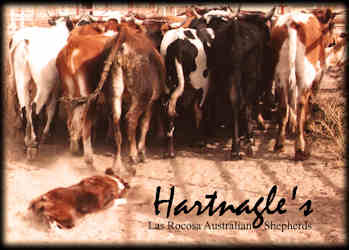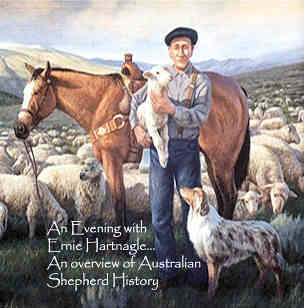 |
||
|
Education: Books, Videos & Herding Clinics
|
An Evening With Ernie Hartnagle DVD
Highlights from Ernie Hartnagle’s Presentation for ASCA’s Golden Jubilee
In a celebration event for ASCA’s 50th Anniversary, the Golden Jubilee Consortium hosted a special evening with Ernie Hartnagle organized by Pete Dolan and Peter Kontos.
My father talked about a variety of topics, mainly the breed’s origins, structural differences between working and show dogs (and how they differ), to the events that occurred during his tenure on the ASCA Board and as President. Among the points covered in the lecture included questions the audience had submitted prior to the Nationals.
He listed the three major proceedings he thought had the greatest impacted on the breed:
1. The forming of the Australian Shepherd Club of America in 1957 to recognized Aussies as a distinct, true breed. 2. The establishment of the registry in both 1958 and in 1972 to record their ancestral lineage as far back as possible and document their lineage for future generations. 3. The adoption of the official Breed Standard in 1977, to describe the physical characteristics of the ideal, mature specimen of the breed as a judging and breeding guideline.
Prior to ASCA’s formation, breed activity was limited to the western states, primarily in Arizona, California, Colorado, Idaho and the Pacific Northwest. Interestingly, he pointed out that California and Idaho are the two states with the biggest Basque population and Idaho is where Jay Sisler lived and the location Juanita Ely ranched prior to relocating in Colorado. The largest community of Basques in North America exists in the greater Boise Idaho area.
He also pointed out that Basque sheepherders were working in Cahuenga Valley long before it became known as Hollywood. Why was that significant? Because many people writing about the breed’s history choose to ignore the eyewitness accounts of the early breeders who lived it.
Eloise Hart, ASCA’s first president was ten-years old when she her family acquired her first dog in 1930. She said, “He was a stocky, bob-tailed, brown dog with an infinite capacity to learn,” wrote Eloise. “Blanco came to California from the Basque sheep country in Spain. His owner was forced to forfeit him, as payment for some minor violation, to a lawyer neighbor of ours when we lived near Wilshire and Vine in Los Angeles.”
Between 1880 and 1930, Los Angeles had a flourishing Basque colony. During those years in the area around Alameda Street and Aliso Street was the home for one of the oldest and largest Basque communities in America. They spread out from there.
Basque sheepherders and their dogs were commonly brought in from Spain and France to the western states including Nevada where the sheep industry was followed by cattle ranching. The Basque people dominated the sheep industry from 1873 to 1973, a period of one hundred years.
By the end of WWII, sheep numbered less than 40 million. America’s viewpoint towards lamb was influenced by the poorly prepared mutton that was served as lamb to the soldiers overseas. When they returned home, they did not want to be served lamb for dinner.
During the 19th century (climaxing in 1942), an estimated 56 million head of sheep were grazed on the open ranges throughout the western half of the United States. Many of the herders came here (on a three year visa) under contract through the Western Range Association. They wrote home and told their brothers to join them, which they did and brought their dogs. Thousands of Basques and their dogs were recruited into western sheep ranches due to the severe labor shortage created during the 1940s and 1950s.
The “little blue dogs” started gaining recognition because they started showing up in the west as the herders brought them in. According to Ken Duart, an early California breeder, a Basque sheepherder running had a bunch of sheep at Rolfs Ranch in San Miguel area had friends coming to California who brought their dogs to the Nelson Ranch they worked around the Bakersfield area in California. The dogs were a tool of their trade and they were able to bring them in without quarrentine.”
One of the dogs brought over was sold to Ken very late in 1959 or early in 1960. He said, “A Basque sheepherder imported two pups from the Basque sector of the French and Spanish border. I purchased Duart’s Lita, a blue merle with one blue eye from a herder at Nelson’s sheep ranch at Bakersfield.”
According to Dave Cook, foreman of the immense Warren Livestock Company headquartered in Cheyenne Wyoming, said that the reason “the little blue (Basque) dogs were preferred over Shepherds (the old fashioned collies) was due to their superior staying power, which was desperately needed to combat the harsh conditions (weather and terrain) of the open range. He said “Old Shep’” was reliable, but lacked the stamina needed for wide spread sheep ranching.”
Of note, was the first OFA certificate was issued to an Aussie, Nelson’s Samantha CDX in 1966, which was the same year the Orthopedic Foundation was established. She was sired by Lees Savage Sam who traced back to Nevada ranch dogs including Ritter’s Streak bred by Roy Ritter. Streak traveled for miles to get help for his master who was hurt from injuries caused when his horse fell down an arroyo and pinned him to the ground. It was dogs like him, selected by decisive factors such as soundness and intelligence which laid the ground work for the future of the breed.
By 1974, the sheep industry continued to decline and there were only 16.5 million sheep in the United States. As the ranching industry dwindled, so did some of the early foundation lines. At this time, Aussies were still the breed of choice on western ranches being tested by the grueling demands of open range ranching. However, more Aussies started finding their way into suburbia.
In outlining events that took place between 1970 and 1978 was the decisive meeting in Redding California. In 1973, Elsie Cotton, a chief participant unexpectedly resigned after trashing out the office during a fit of rage leaving the club in a lurch. An emergency meeting was held in Redding California and a small handful of members gathered together to determine the future of ASCA and its registry. Gwen Stevenson, Ernie and Elaine Hartnagle, Phil and Ann Wildhagen, Steve Stephenson (Stock Dog Chairman), Billie Jean Newman (the ASCA Registrar), Bob and Jean Carrillo, Jim and Kit Malone, Carol Behrend, Leslie Sharp, Vicki and Sam Mistretta and Johnnie and Wanda Robertson were among the 24 members who attended the meeting. They gathered because they had one thing in common...the love of the Australian Shepherd breed.
In 1975, he was elected to serve as the ASCA President. When he took over the office in January 1976 he had the books audited and to his surprise discovered there was a total sum of $15.00 in the treasury. “This sobering fact was proof positive that ASCA was indeed a non profit organization,” he said with a grin.
By 1976, there were 3,000 ASCA registered Aussies and in 1978, registration doubled at 6,000. In recounting the events, he said, the Junior Showmanship program was the greatest activity program that was ever developed by ASCA. This program not only insured that the future of the Breed would be guided by our dedicated youth of today, it also teaches them responsibility, aids in developing character and other traits that will help them in their future journey through life.
One of the major points of interest was his conversation on structure based on the discussion in his recently published book, The Total Australian Shepherd. Most importantly, he established that the original Aussie was a sprinting breed. Yet after the show program was put into effect; a new type of Aussie started appearing on the scene, the development of the trotting Aussie. He made clear the reasons how they are different. To illustrate his point he showed pictures of early ranch dogs that became the foundation of the breed.
In conclusion, the evening was a great success. While my father was only able to scratch the surface, auditors were refreshed by the wealth of information he shared, seasoned with his quaint sense of humor.
For those who were unable to attend, the lecture was taped and is available on DVD. For more information please visit:
Stewardship and Education page Copyright © 2011 Jeanne Joy Hartnagle-Taylor. All Rights Reserved.
|
|
